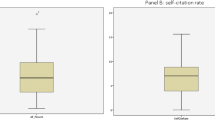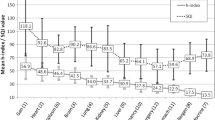Abstract
Purpose
This paper compares the traditional tools of calculation for a journal’s efficacy and visibility with the new tools that have arrived from the Internet, social media and search engines. The examples concern publications of orthopaedic surgery and in particular International Orthopaedics.
Methods and results
Until recently, the prestige of publications, authors or journals was evaluated by the number of citations using the traditional citation metrics, most commonly the impact factor. Over the last few years, scientific medical literature has developed exponentially. The Internet has dramatically changed the way of sharing and the speed of flow of medical information. New tools have allowed readers from all over the world to access information and record their experience. Web platforms such as Facebook® and Twitter® have allowed for inputs from the general public. Professional sites such as LinkedIn® and more specialised sites such as ResearchGate®, BioMed Central® and OrthoEvidence® have provided specific information on defined fields of science. Scientific and professional blogs provide free access quality information. Therefore, in this new era of advanced wireless technology and online medical communication, the prestige of a paper should also be evaluated by alternative metrics (altmetrics) that measure the visibility of the scientific information by collecting Internet citations, number of downloads, number of hits on the Internet, number of tweets and likes of scholarly articles by newspapers, blogs, social media and other sources of data.
Conclusions and discussion
This article provides insights into altmetrics and informs the reader about current tools for optimal visibility and citation of their work. It also includes useful information about the performance of International Orthopaedics and the bias between traditional publication metrics and the new alternatives.


Similar content being viewed by others
References
Rennie D (1998) The present state of medical journals. Lancet 352(Suppl II):SII18–SII22
Sechrest RC (2010) The Internet and the physician-patient relationship. Clin Orthop Relat Res 468(10):2566–2571
Moverley R, Rankin KS, McNamara I, Davidson DJ, Reed M, Sprowson AP (2013) Impact factors of orthopaedic journals between 2000 and 2010: trends and comparisons with other surgical specialties. Int Orthop 37(4):561–567
Garfield E (1999) Journal impact factor: a brief review. CMAJ 161:979–980
Garfield E (1955) Citation indexes to science: a new dimension in documentation through association of ideas. Science 122:108–111
Hakkalamani S, Rawal A, Hennessy MS, Parkinson RW (2006) The impact factor of seven orthopaedic journals: factors influencing it. J Bone Joint Surg Br 88:159–162
Kurmis AP (2003) Understanding the limitations of the journal impact factor. J Bone Joint Surg Am 85-A:2449–2454
Seglen PO (1997) Why the impact factor of journals should not be used for evaluating research. BMJ 314:498–502
Siebelt M, Siebelt T, Pilot P, Bloem RM, Bhandari M, Poolman RW (2010) Citation analysis of orthopaedic literature; 18 major orthopaedic journals compared for impact factor and SCImago. BMC Musculoskelet Disord 11:4
Bergstrom CT, West JD (2008) Assessing citations with the Eigenfactor™ metrics. Neurology 71:1850–1851
Bosker BH, Verheyen CCPM (2006) The international rank order of publications in major clinical orthopaedic journals from 2000 to 2004. J Bone Joint Surg Br 88:156–158
Rossner M, Van Epps H, Hill E (2007) Show me the data. J Cell Biol 179(6):1091–1092
Garfield E (1996) How can impact factors be improved? BMJ 313:411–413
Hemmingsson A, Mygind T, Skjennald A, Edgren J (2002) Manipulation of impact factors by editors of scientific journals. AJR Am J Roentgenol 178:767
The PLoS Medicine Editors (2006) The impact factor game. It is time to find a better way to assess the scientific literature. PLoS Med 3:e291
Mavrogenis AF, Ruggieri P, Papagelopoulos PJ (2010) Self-citation in publishing. Clin Orthop Relat Res 468(10):2803–2807
Falagas ME, Kouranos VD, Arencibia-Jorge R, Karageorgopoulos DE (2008) Comparison of SCImago journal rank indicator with journal impact factor. FASEB J 22:2623–2628
SCImago Research Group (2008) Description of SCImago Journal Rank Indicator. http://www.scimagojr.com/SCImagoJournalRank.pdf. Accessed 20 Jan 2008
Bergstrom CT, West JD, Wiseman MA (2008) The Eigenfactor™ metrics. J Neurosci 28(45):11433–11434
http://admin-apps.webofknowledge.com/JCR/help/h_eigenfact.htm. Accessed 20 Apr 2015
http://www.eigenfactor.org. Accessed 6 Apr 2010
de Solla Price DJ (1965) Networks of scientific papers. Science 30;149(3683):510–515
https://en.wikipedia.org/wiki/Altmetrics. Accessed 20 Apr 2015
http://www.journalindicators.com/methodology#sthash.rDKA5eQY.dpuf. Accessed 2 Jan 2015
Haustein S, Peters I, Sugimoto CR, Thelwall M, Larivière V (2014) Tweeting biomedicine: an analysis of tweets and citations in the biomedical literature. J Assoc Inf Sci Technol 65:656–669
http://shoulderarthritis.blogspot.com/ Accessed 5 Mar 2015
Daniilidis KL, Tibesku CO (2013) Frontal plane alignment after total knee arthroplasty using patient-specific instruments. Int Orthop 37(1):45–50. doi:10.1007/s00264-012-1732-1
Iwai TL, Tsuji S, Tomita T, Sugamoto K, Hideki Y, Hamada M (2013) Repeat-dose intravenous tranexamic acid further decreases blood loss in total knee arthroplasty. Int Orthop 37(3):441–445. doi:10.1007/s00264-013-1787-7
Scarlat MM (2013) Complications with reverse total shoulder arthroplasty and recent evolutions. Int Orthop 37(5):843–851. doi:10.1007/s00264-013-1832-6
Petersen W, Rembitzki IV, Brüggemann GP, Ellermann A, Best R, Koppenburg AG, Liebau C (2014) Anterior knee pain after total knee arthroplasty: a narrative review. Int Orthop 38(2):319–328. doi:10.1007/s00264-013-2081-4
Wei J, Song Y, Sun L, Lv C (2013) Comparison of artificial total disc replacement versus fusion for lumbar degenerative disc disease: a meta-analysis of randomized controlled trials. Int Orthop 37(7):1315–1325. doi:10.1007/s00264-013-1883-8
Wang X, Wang Y, Gou W, Lu Q, Peng J, Lu S (2013) Role of mesenchymal stem cells in bone regeneration and fracture repair: a review. Int Orthop 37(12):2491–2498. doi:10.1007/s00264-013-2059-2
Pfeifer C, Müller M, Prantl L, Berner A, Dendorfer S, Englert C (2012) Cartilage labelling for mechanical testing in T-peel configuration. Int Orthop 36(7):1493–1499. doi:10.1007/s00264-011-1468-3
Craik JD, Mallina R, Ramasamy V, Little NJ (2014) Human evolution and tears of the rotator cuff. Int Orthop 38(3):547–552. doi:10.1007/s00264-013-2204-y
Ferretti A, Valeo L, Mazza D, Muliere L, Iorio P, Giovannetti G, Conteduca F, Iorio R (2014) Smartphone versus knee ligament arthrometer when size does not matter. Int Orthop 38(10):2197–2199. doi:10.1007/s00264-014-2432-9
Pećina M (2015) International orthopaedics today. Int Orthop 39(3):381–382. doi:10.1007/s00264-014-2638-x
Author information
Authors and Affiliations
Corresponding author
Rights and permissions
About this article
Cite this article
Scarlat, M.M., Mavrogenis, A.F., Pećina, M. et al. Impact and alternative metrics for medical publishing: our experience with International Orthopaedics . International Orthopaedics (SICOT) 39, 1459–1464 (2015). https://doi.org/10.1007/s00264-015-2766-y
Received:
Accepted:
Published:
Issue Date:
DOI: https://doi.org/10.1007/s00264-015-2766-y




